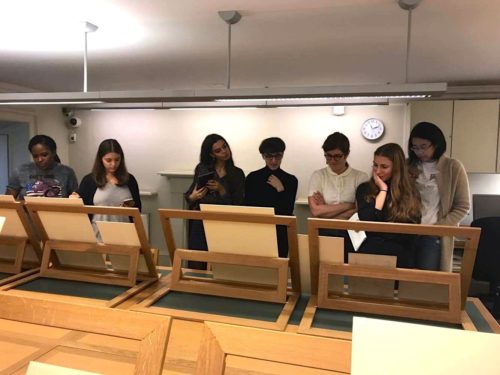As the dissertation deadline looms, we’re spending some time getting to know the current MA Documenting Fashion students. Genevieve discusses Austrian fashion designer Maria Likarz, the modern woman as machine and her love of jewellery with a story.
What is your dissertation about?
I am writing about Maria Likarz, an incredible Austrian fashion designer who worked at the Wiener Werkstätte, a cooperative design workshop in Vienna, during its tenure from 1903-1932. This period saw the rise of many famous fashion names, including Coco Chanel, Paul Poiret, and Madeleine Vionnet, but no one has ever heard of Maria Likarz! Dress history during this period tends to focus on France, so delving into Austrian fashion has been really fun. The diversity of Likarz’s talents was profound; she created fashion designs, jewellery, textiles, ceramics, lace, and even a few collections of wallpaper. I could spend all day looking at her designs in the archive of Vienna’s Museum of Applied Arts.

Wiener Werkstätte Archive, Museum of Applied Art, Vienna.

Museum of Applied Art, Vienna.

Museum of Applied Art, Vienna.
What is your favourite thing that you’ve written/worked on/researched this year?
I would say my Virtual Exhibition, and my dissertation is running a really close second. I designed my exhibition around the connection between women and machinery in the early twentieth century. Some of my favourite exhibits included Fernand Léger’s 1924 silent film, Ballet mécanique, a recreation of an automobile painted by Sonia Delaunay, a Kodak Ensemble from 1929, and Look 17 from Prada’s Spring 2012 ready-to-wear collection. Honestly, I loved every exhibit. That exhibition is one of the coolest projects I have ever done!

Automobile c. 1920, painted later
Museo Automovilístico y de la Moda
Málaga, Spain
Favourite dress history image?
Narrowing down one choice was a battle, but this Norman Parkinson photograph for Vogue in 1950 is one of my favourite fashion photographs of all time. The subject, Mary Drage, was an English ballerina for Sadler’s Wells Ballet. She stands in front of John Singer Sargent’s 1899 painting The Wyndham Sisters: Lady Elcho, Mrs. Adeane, and Mrs. Tennant. I love this image because Drage’s grace and delicate elegance suggest she stepped right out of the painting. After endless months of leggings and sweatshirts, the sumptuous tactility of each gown makes me long for the time when we can all finally dress up again.

What are you wearing today?
With our dissertation deadline fast approaching, it is a library day for me. So, I am wearing a pair of teal, white, and navy flowy pants from Calypso, a white V-neck t-shirt, and my favourite gunmetal grey Chanel flats. I also have my softest white knit cardigan on hand because I get cold so easily! And can’t forget those blue light glasses.
How would you describe your style?
A tough one! I went through several different phases during my high school and university years. When I asked a friend, she described my current style as ‘cosmopolitan chic.’ I like to think of it as classic and elegant. I prefer to shop vintage, I wear a lot of black, and I love bold or patterned jackets. Give me an LBD and some black, heeled booties and I am happy. That being said, I could never function without jeans and trainers. I also adore jewellery. Some of my favourite pieces include a gold ring given by my dad to my mom, which she then passed down to me; my small ruby and gold hoops; and a set of gold bangles (another family heirloom!). I love any piece of clothing or jewellery with a story behind it.
What are you hoping to do next?
After finishing my MA, I am hoping to return to an auction house, gallery, or fashion house. I would also love to work at a museum in the dress department. I have worked in the luxury industry in the past and can’t wait to jump back in!
Do you have an early fashion memory to share?
When I was three or four, I was the flower girl in my aunt’s wedding. There is an amazing photo of me wearing this gorgeous lilac dress with flowers around the neckline. I was completely obsessed with the dress until my parents gave me a piece of wedding cake, and the photo shows me, in my pretty dress, stuffing cake into my mouth with my hands. Luckily, the dress remained pristine!





